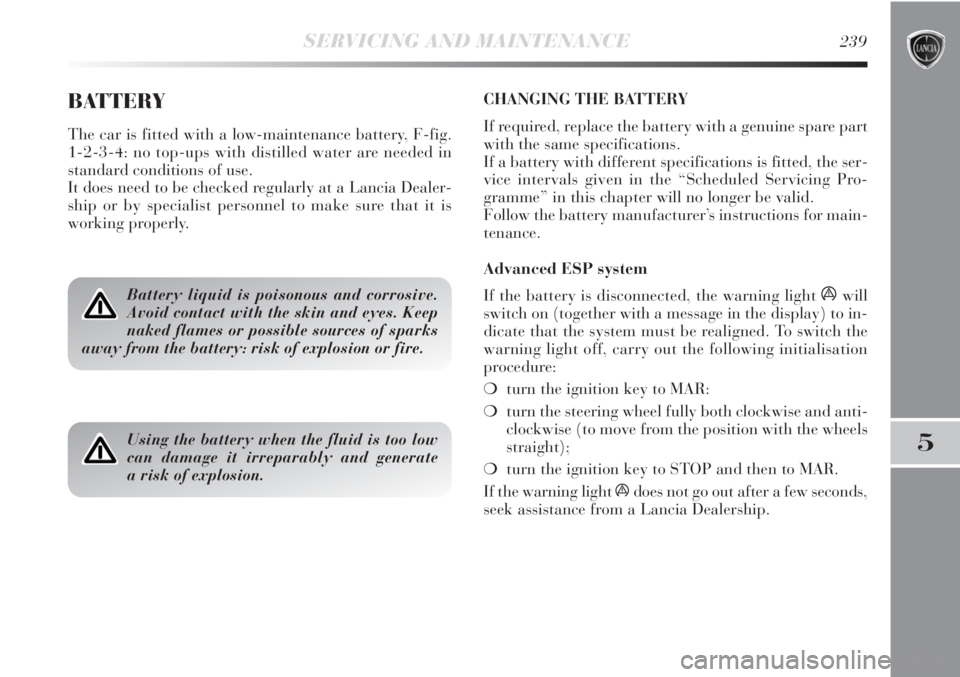Page 238 of 290

SERVICING AND MAINTENANCE237
5
WINDSCREEN/REAR WINDOW WASHER FLUID
C-fig. 1-2-3-4
Remove the cap, using the special tab, to add fluid.
Use a mixture of water and TUTELA PROFESSIONAL
SC 35, in the following concentrations:
❍30% TUTELA PROFESSIONAL SC 35 and 70% wa-
ter in summer.
❍50% TUTELA PROFESSIONAL SC 35 and 50% wa-
ter in winter.
At temperatures below −20 °C, use undiluted TUTELA
PROFESSIONAL SC 35 fluid.
Check level through the reservoir.
Close the cap by pressing the centre section.
Do not travel if the windscreen washer
reservoir is empty: using the windscreen
washer is essential for improving visibility.
Some commercial windscreen washer additives
are flammable. The engine compartment contains
hot parts which could start a fire if they come into
contact.
BRAKE FLUID D-fig. 1-2-3-4
Undo the cap and check that the liquid contained in the
reservoir is at the maximum level. The fluid level in the
reservoir must not exceed the MAX mark. If you need to
top up, you should use the brake fluid shown in the “Flu-
ids and lubricants” table (see chapter “6”).
NOTE Carefully clean the cap of the reservoir and the
surrounding surface.
Take great care to ensure that impurities do not enter the
reservoir when the cap is opened.
For topping-up, always use a funnel with integrated fil-
ter with mesh equal to or lower than 0.12 mm.
IMPORTANT Brake fluid is hygroscopic (i.e. it absorbs
moisture). For this reason, if the car is mainly used in ar-
eas with a high degree of atmospheric humidity, the fluid
should be replaced at more frequent intervals than spec-
ified in the “Scheduled Servicing Programme”.
Page 240 of 290

SERVICING AND MAINTENANCE239
5
BATTERY
The car is fitted with a low-maintenance battery, F-fig.
1-2-3-4: no top-ups with distilled water are needed in
standard conditions of use.
It does need to be checked regularly at a Lancia Dealer-
ship or by specialist personnel to make sure that it is
working properly.
Battery liquid is poisonous and corrosive.
Avoid contact with the skin and eyes. Keep
naked flames or possible sources of sparks
away from the battery: risk of explosion or fire.
Using the battery when the fluid is too low
can damage it irreparably and generate
a risk of explosion.
CHANGING THE BATTERY
If required, replace the battery with a genuine spare part
with the same specifications.
If a battery with different specifications is fitted, the ser-
vice intervals given in the “Scheduled Servicing Pro-
gramme” in this chapter will no longer be valid.
Follow the battery manufacturer’s instructions for main-
tenance.
Advanced ESP system
If the battery is disconnected, the warning light
áwill
switch on (together with a message in the display) to in-
dicate that the system must be realigned. To switch the
warning light off, carry out the following initialisation
procedure:
❍turn the ignition key to MAR:
❍turn the steering wheel fully both clockwise and anti-
clockwise (to move from the position with the wheels
straight);
❍turn the ignition key to STOP and then to MAR.
If the warning light ádoes not go out after a few seconds,
seek assistance from a Lancia Dealership.
Page 245 of 290

244SERVICING AND MAINTENANCE
RUBBER HOSES
As far as the brake system and fuel rubber hoses are con-
cerned, follow the “Scheduled Servicing Programme” in
this chapter carefully.
Ozone, high temperatures and prolonged lack of fluid in
the system may cause hardening and cracking of the
hoses, with possible leaks. Careful checking is therefore
necessary.
WINDSCREEN/REAR WINDOW
WIPER
BLADES
Periodically clean the rubber part using special products;
TUTELA PROFESSIONAL SC 35 is recommended.
Replace the blades if the rubber edge is deformed or worn.
In any case, it is advisable to replace them approximately
once a year.
A few simple precautions can reduce the possibility of
damage to the blades:
❍make sure that the rubber part is not frozen to the
windscreen in sub-zero temperatures. Use an an-
tifreeze product to release it if required;
❍remove any snow from the glass: in addition to pro-
tecting the blades, this prevents effort from the motor
and overheating;
❍do not operate the windscreen and the rear screen
wipers on dry glass.
Driving with worn wiper blades is a seri-
ous hazard, because visibility is reduced
in bad weather.